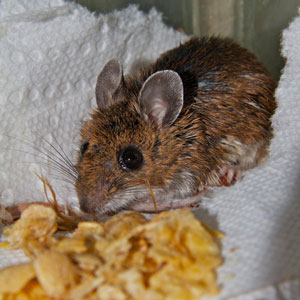What Does a Deer Mouse Look Like?
By Chris Williams on November 21, 2013.

Question
I’ve read that the deer mouse is the mouse that spreads hantavirus, not the house mouse. I’ve occasionally seen a mouse in my basement. How do I know if these are deer mice or house mice?
Answer
Good question, but first let me explain about hantavirus. It’s a very rare disease in the Northeast. Hantavirus occurs primarily in drier western parts of the U.S. It is spread to humans mostly when airborne virus particles are inhaled and is more common in dry, dusty areas where there are accumulations of mouse urine and droppings (also known as mouse “poop”) that contain the virus. The disease is spread by the deer mouse, and occasionally by the white-footed mouse.
For us in the Northeast, it’s more important to know that deer mice are part of the Lyme disease cycle. The black-legged tick (we used to call it the deer tick) feeds on deer mice and white-footed mice which can carry Lyme disease and pass it on to the ticks. You won’t get Lyme disease from the mice but you could get Lyme disease from ticks that have fed on infected mice.
It’s very possible that the mice you have in your basement are deer mice since they are becoming increasingly common in homes. The term “deer mouse” seems to be used interchangeably for either the deer mouse or the closely related white-footed mouse. Years ago, house mice were the indoor mice and deer mice were the outdoor mice. Not any more. In some areas, deer mice are actually the most common mouse in homes.
It’s the “Cute” Pest Mouse!
Deer mice and house mice are pretty easy to tell apart, especially if you have the two side by side or can refer to a picture on the internet. They’re about the same size, but I always think of deer mice as “cuter” than house mice. They have larger ears and larger eyes and are two-tone, with a white belly and feet. The house mouse, in contrast is all gray or grayish brown (no white belly), with smaller eyes and ears. Think of the deer mouse as resembling a deer in coloration, being a tawny brown above and white beneath. The deer mouse also has a hairy tail (also brown above and white below), while the house mouse’s tail is mostly gray and hairless.
Inside homes, the deer mouse nests in the same sites as the house mouse, but their nests are often larger, sometimes more than a foot in diameter. Both mice tend to hoard food in their nests and in other sites, but the deer mouse will often carry in large amounts of nuts and seeds and stash them in places like wall voids or dresser drawers.
While hantavirus is rare in the Northeast, it is always a possibility whenever an old accumulation of mouse droppings is cleaned up or disturbed. If you are faced with a situation like cleaning up an old cabin where deer mice have been the primary occupants, you should take precautions to avoid inhaling virus particles. Wet down the droppings first and wear a respirator while working. Fortunately, deer mice are controlled in the same manner as house mice. Snap traps and mouse baits work just fine. If you need professional help with mouse control, give Colonial a call.